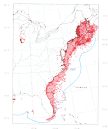Marine Geology Data
US Geological Survey
Database of Grain size and Composition of
Marine Sediment Samples from the US East Coast
March 7, 1994 version
World Data Center for Geophysics & Marine Geology, Boulder

the text below and data files are reproduced from the original USGS Web page
http://woodshole.er.usgs.gov/datapages/hathaway-sediments/
(13-June-2000 Web page version)
For related data available from the USGS, see USGS Open File Report OFR00-358
data format description
(file structure.txt)
This database contains data on collection, location, description, and
texture of samples taken by the marine sampling programs of the Branch of
Atlantic Marine Geology of the US Geological Survey. Most of the samples
are from the Atlantic Continental Margin of the United States, but some
are from as diverse locations as Lake Baikal, Russia, the Hawaiian Islands
region, Puerto Rico, the Gulf of Mexico, and Lake Michigan. The database
contains data for about 12,000 samples and includes texture data for
approximately 2300 samples taken or analyzed by the Atlantic Continental
Margin Program, a joint US Geological Survey/Woods Hole Oceanographic
Institution project conducted from 1962 to 1970. This program was under
the direction of K.O. Emery from 1962 to 1968, and the data were
originally reported in Hathaway (WHOI Report 71-15, 1971).
Texture data for approximately 8000 samples analyzed by the Sediment
Laboratory of the Branch of Atlantic Marine Geology of the US Geological
Survey, Woods Hole MA. after 1980 are also included. Considerable data
from the period 1970 to 1980 are yet to be digitized and added.
IMPORTANT NOTE:
This database is in "flat file" form, which means that it is not
"normalized". While this is considered inefficient from the point of view
of database management, it is the simplest way of presenting the basic data.
Since I know neither the software capabilities of the user nor the
probable uses that may be made of the data, I have made no attempt to split
the files to reduce blank regions or remove redundancies.
The same data may be presented in more than one form, e.g.: phi class
frequencies and cumulative frequencies. Even though each form can be derived
from the other, presenting both eliminates the need for the user to program
formulas to calculate one from the other. Although this may violate the
principal of having a single entry for any given data item, it greatly
simplifies the use of the file. If the user wishes to make the data base
more efficient through "normalization", I feel that it is better that this
be done by the user to fit both the applications available to the user and
the database structural logic that is familiar to the user. The price paid
for the "flat file" approach is additional storage space, rather wide
records, and the possibility that corrections made here at the source may
fail to be carried through to all forms of the data affected. We will
make every effort to see that this last possibility does not happen.
The files in this database are under three subdirectories from the USGS, only the ASCII version is reproduced for download from NGDC:
ASCGROUP (local download from NGDC ftp)
This directory contains the data and headings for
the tables of data in uncompressed ASCII format.
Use these files if you are not using a DOS or
Windows compatible computer and wish to import the data
into applications that can accept ASCII character
information.
See the README and structur.doc files for more information
This database was assembled by John C. Hathaway, Geologist Emeritus,
US Geological Survey, and is now managed by Polly Shoukimas
Version of
March 7, 1994
DISCLAIMER
This database, identified as Branch of Atlantic Marine Geology Sediment
Database, has been approved for release and publication by the Director
of the USGS. Although this database has been subjected to rigorous review
and is substantially complete, the USGS reserves the right to revise the
data pursuant to further analysis and review. Furthermore, it is released
on condition that neither the USGS nor the United States Government may be
held liable for any damages resulting from its authorized or unauthorized
use.
The above information was modified from a document generated by the USGS
SEARCHABLE DATA INVENTORY
NGDC/WDC GMG, Boulder archives a wide variety of digital marine geology data collections, paper reports, microfilm, etc. containing sediment and hardrock data. Many of the digital files are available for direct download. Sample-by-sample inventory information for all data, regardless of format available from NGDC are fully searchable through the marine geology inventory (GEOLIN).
|